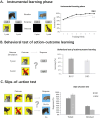Increasingly dependent on habit? A study on the electrophysiological mechanisms of goal-directed and habitual control in internet gaming disorder
- PMID: 40372798
- PMCID: PMC12231473
- DOI: 10.1556/2006.2024.00084
Increasingly dependent on habit? A study on the electrophysiological mechanisms of goal-directed and habitual control in internet gaming disorder
Abstract
Background: Public health issues arising from excessive online gaming have garnered significant research interest. Existing studies indicate that, within the framework of the dual-systems theory, the equilibrium between the goal-directed and habitual control systems is disrupted in patients with Internet gaming disorder (IGD). Nevertheless, the understanding of how this imbalance manifests within the brain is limited. This study aims to investigate real-time brain activity in individuals with IGD during the activation of both the goal-directed and habitual systems using electrophysiological techniques.
Methods: Twenty-four individuals with IGD and twenty-three matched recreational game users (RGUs) underwent electroencephalography (EEG) data collection while completing an outcome devaluation task. Differences between the two groups at the Fz, Cz, and Pz electrodes were compared using repeated measures ANOVA.
Results: The behavioral results revealed that the RGU group exhibited higher accuracy than the IGD group during the learning phase (t(45) = -3.08, p < 0.001, η2 = 0.42). During the slip-of-action test, the IGD group made more action-slip responses for devalued outcomes than the RGU group (F(1,45) = 6.22, p = 0.016, η2 = 0.12). The EEG experiment results indicated that, upon stimulus presentation during the slip-of-action test, the IGD group had significantly more negative average amplitudes at the Fz and Cz electrodes compared with the RGUs (-7.26 ± 6.28 μV; -5.18 ± 5.49 μV; F(1,40) = 5.54, p = 0.024, η2 = 0.12; F(1,40) = 4.92, p = 0.032, η2 = 0.11). Concurrently, the single-group analysis based on RGU revealed that habitual control appears to be associated with greater N2 and P3 amplitudes during the stimulus-locked phase.
Conclusions: The goal-directed system of individuals with IGD is impaired, manifesting in the increased cognitive resources required to activate the goal-directed system when they need to disrupt habitual responses. This suggests that the imbalance due to IGD within the dual systems may originate from an impaired goal-directed system rather than the overactivation of the habitual system.
Keywords: electroencephalography; goal–directed; habitual; instrumental learning; internet gaming disorder.
Conflict of interest statement
Figures





Similar articles
-
Imbalanced goal-directed and habitual control in individuals with internet gaming disorder.J Behav Addict. 2025 Apr 28;14(2):831-845. doi: 10.1556/2006.2025.00037. Print 2025 Jul 2. J Behav Addict. 2025. PMID: 40293819 Free PMC article.
-
Altered dynamic reconfiguration of brain functional networks during gaming and deprivation in individuals with internet gaming disorder.J Behav Addict. 2025 May 13;14(2):776-792. doi: 10.1556/2006.2025.00036. Print 2025 Jul 2. J Behav Addict. 2025. PMID: 40366753 Free PMC article.
-
Longitudinal Network Relationships Between Symptoms of Deviant Peer Affiliation and Internet Gaming Disorder in Adolescents: Prospective Cohort Study.J Med Internet Res. 2025 Jun 13;27:e72543. doi: 10.2196/72543. J Med Internet Res. 2025. PMID: 40513001 Free PMC article.
-
The Black Book of Psychotropic Dosing and Monitoring.Psychopharmacol Bull. 2024 Jul 8;54(3):8-59. Psychopharmacol Bull. 2024. PMID: 38993656 Free PMC article. Review.
-
Home treatment for mental health problems: a systematic review.Health Technol Assess. 2001;5(15):1-139. doi: 10.3310/hta5150. Health Technol Assess. 2001. PMID: 11532236
References
-
- 2022 China game Industry report. (2023). http://www.cadpa.org.cn/3271/202302/41574.html.
-
- APA (2013). Diagnostic and statistical manual of mental disorders: DSM-5™ (5th ed.). American Psychiatric Publishing, Inc. 10.1176/appi.books.9780890425596. - DOI
MeSH terms
LinkOut - more resources
Full Text Sources

